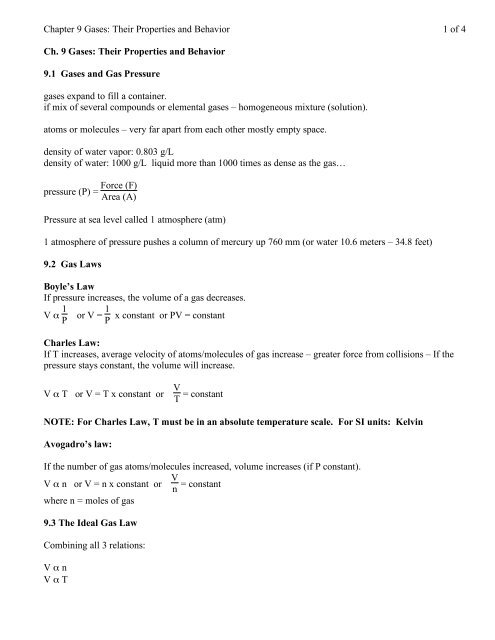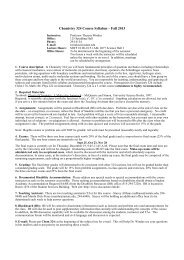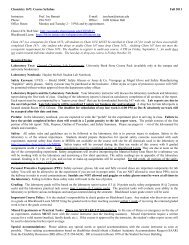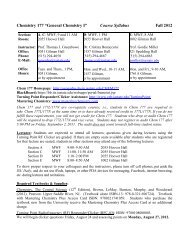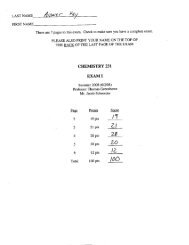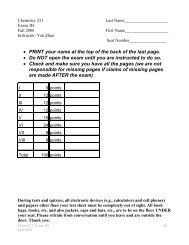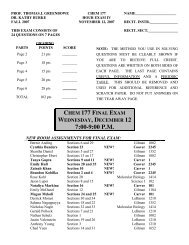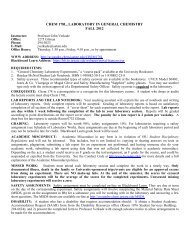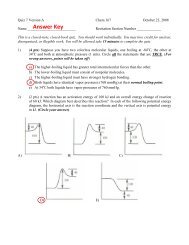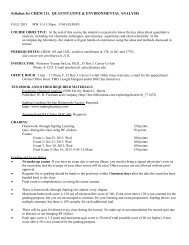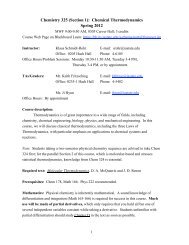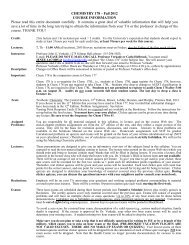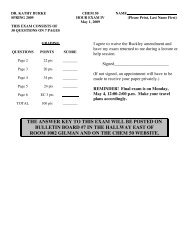Chapter 9 Gases: Their Properties and Behavior 1 of 4 Ch. 9 Gases ...
Chapter 9 Gases: Their Properties and Behavior 1 of 4 Ch. 9 Gases ...
Chapter 9 Gases: Their Properties and Behavior 1 of 4 Ch. 9 Gases ...
You also want an ePaper? Increase the reach of your titles
YUMPU automatically turns print PDFs into web optimized ePapers that Google loves.
<strong><strong>Ch</strong>apter</strong> 9 <strong>Gases</strong>: <strong>Their</strong> <strong>Properties</strong> <strong>and</strong> <strong>Behavior</strong> 1 <strong>of</strong> 4<strong>Ch</strong>. 9 <strong>Gases</strong>: <strong>Their</strong> <strong>Properties</strong> <strong>and</strong> <strong>Behavior</strong>9.1 <strong>Gases</strong> <strong>and</strong> Gas Pressuregases exp<strong>and</strong> to fill a container.if mix <strong>of</strong> several compounds or elemental gases – homogeneous mixture (solution).atoms or molecules – very far apart from each other mostly empty space.density <strong>of</strong> water vapor: 0.803 g/Ldensity <strong>of</strong> water: 1000 g/L liquid more than 1000 times as dense as the gas…pressure (P) =Force (F)Area (A)Pressure at sea level called 1 atmosphere (atm)1 atmosphere <strong>of</strong> pressure pushes a column <strong>of</strong> mercury up 760 mm (or water 10.6 meters – 34.8 feet)9.2 Gas LawsBoyle’s LawIf pressure increases, the volume <strong>of</strong> a gas decreases.V α 1 Por V = 1 Px constant or PV = constant<strong>Ch</strong>arles Law:If T increases, average velocity <strong>of</strong> atoms/molecules <strong>of</strong> gas increase – greater force from collisions – If thepressure stays constant, the volume will increase.V α T or V = T x constant orVT = constantNOTE: For <strong>Ch</strong>arles Law, T must be in an absolute temperature scale. For SI units: KelvinAvogadro’s law:If the number <strong>of</strong> gas atoms/molecules increased, volume increases (if P constant).VV α n or V = n x constant orn = constantwhere n = moles <strong>of</strong> gas9.3 The Ideal Gas LawCombining all 3 relations:V α nV α T
<strong><strong>Ch</strong>apter</strong> 9 <strong>Gases</strong>: <strong>Their</strong> <strong>Properties</strong> <strong>and</strong> <strong>Behavior</strong> 2 <strong>of</strong> 4V α 1 PV α n TPor V = n TPR => PV = nRT called the “Ideal Gas Equation” (know)where R is called the gas constant; Given on exams: R = 0.08206liter atmmol KExample: What is the volume <strong>of</strong> 1.00 mol <strong>of</strong> gas under st<strong>and</strong>ard state conditions (0 o C, 1 atm)?PV = nRTV = nRTPneed T in K: 0 + 273 = 273 KV = 1.00 mol 0.08206 liter atm mol-1 K -1 273 K1.00 atmcalled the molar volume <strong>of</strong> a gas.All gases, 1 atm, 273 K, 1 mol: occupy 22.4 L= 22.4 LCan use ideal gas equation to calculate changes in variables given new conditions.Example: Suppose that a balloon has a volume <strong>of</strong> 10.2 liters at a pressure <strong>of</strong> 1.00 atm <strong>and</strong> a temperature <strong>of</strong>25.2 o C. The balloon is submerged in water to a depth where the pressure is 1.30 atm. The volume hasdecreased to 7.69 liters. What is the temperature <strong>of</strong> the water.PV = nRT; n, R are constant, so rearrange ideal gas equation to put all constants on one side <strong>and</strong> allvariables on the other.initial conditions:P 1 V 1T 1= nRfinal conditions:P 2 V 2T 2= nR <strong>and</strong>:rearrange to solve for unknown:P 1 V 1T 1= P 2V 2T 2T 2 = P 2V 2 T 1P 1 V 1T 1 = 25.0 + 273.15 = 298.1 5 KT 2 = 1.30 atm x 7.69 l x 298.1 5 o C1 atm x 10.2 l= 292.2 K (19.1 o C)Use units!
<strong><strong>Ch</strong>apter</strong> 9 <strong>Gases</strong>: <strong>Their</strong> <strong>Properties</strong> <strong>and</strong> <strong>Behavior</strong> 3 <strong>of</strong> 49.4 Stoichiometry Relationships With <strong>Gases</strong><strong>Gases</strong> <strong>and</strong> rxn eqns:Knowing P, V, T, can calculate the moles <strong>of</strong> gas for use with a rxn equation.Example: How many g <strong>of</strong> KClO 3 need to be decomposed to make 50.0 l <strong>of</strong> O 2 ? P= 1 atm, T = 273 K.2 KClO 3 (s) 2 KCl (s) + 3 O 2 (g)V O2 n O2 n KClO3 m KClO3PV = nRT => n = PVRT = 1.00 atm x 50.0 l0.08206 l atm mol –1 K –1 x 273.15 Kn = 2.23 mol O 22.23 mol O 2 ⎝ ⎜⎛ 2 mol KClO 33 mol O ⎠ ⎟⎞2⎝ ⎜⎛ 122.6 g1 mol KClO ⎠ ⎟⎞ = 182 g3The ideal gas law applies to all gases, therefore addition <strong>of</strong> 2 different gases together, would expectpressures to be additive.9.5 Gas Mixtures <strong>and</strong> Partial PressuresDalton’s Law <strong>of</strong> partial pressures (9.5)P total = P 1 + P 2 + P 3 +…mole fraction = X =n 1n totalP 1 = n 1n totalP total = X P totalExample: What is the mole fraction <strong>of</strong> O 2 in air. Assume P = 0.998 atm <strong>and</strong> P O2 = 0.209 atm.P O2 = X P total => X = P O2 0.209 atm=P total 0.998 atm = 0.2099.6 Kinetic Molecular Theory– explain all the observed laws.Postulates:1. <strong>Gases</strong> consist <strong>of</strong> molecule/atoms in continuous r<strong>and</strong>om motion2. The volume occupied by molecules negligible compared to vessel.3. Attractive <strong>and</strong> repulsive forces between species are negligible.4. Energy can be transferred by collisions, but total E is conserved, so average E constant.5. Average KE proportional to absolute T.
<strong><strong>Ch</strong>apter</strong> 9 <strong>Gases</strong>: <strong>Their</strong> <strong>Properties</strong> <strong>and</strong> <strong>Behavior</strong> 4 <strong>of</strong> 4Pressure is due to collision or species on walls <strong>of</strong> vessel. Decreasing the volume by half, doubles thenumber <strong>of</strong> collisions.Doubling the number <strong>of</strong> particles doubles the number <strong>of</strong> collisions, doubling the pressure.Doubling the T, doubles the average kinetic energy, doubling the frequency <strong>of</strong> the collisions, doubling thepressure.9.8 The <strong>Behavior</strong> <strong>of</strong> Real <strong>Gases</strong>Real gases DO deviate from the ideal gas law.At high pressures – gases occupy a significant fraction <strong>of</strong> the vessel volume <strong>and</strong> forces <strong>of</strong> attraction morelikely – so greater deviations from ideal behavior.At low temperatures – gases have lower kinetic energies relative to attractive forces – so less ideal behavior.


